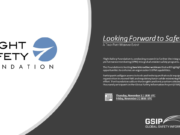
Dear Stakeholders:
It’s time that I report back on what is going on with our Global Safety Information Project (GSIP). We had a busy month in July, visiting many countries for our first round of focus groups. You may recall that this project is about enhancing the world’s ability to effectively use aviation safety data through voluntary safety programs. This source of information is key to advancing the world’s safety record and must be protected so that we can ensure its full and rich potential use in preventing future accidents. I want you all to know what we have heard through our visits and discussions.
Our first tactical exercise is to conduct focus groups with key aviation safety stakeholders, and during the month of July, we have done that in Wellington, New Zealand; Sydney, Australia; Singapore; Mexico City, Mexico; and Panama City, Panama. We have involved representatives of regulators, airline operators, labor groups, air navigation service providers (ANSPs) and airports to get a good cross section of knowledge from all areas of the Industry.
During these five focus groups, I have certainly heard quite a bit of optimism — and at the same time, guarded concern — on how aviation safety data is currently used and what may be done in the future. Anyone who has implemented safety reporting systems probably is familiar with the process of receiving new information that describes hazards while also understanding that the information is limited in its ability to fully define risk.
Here is a summary of what people are telling us during these first focus groups, broken down into four major categories of activity:
- On reliability of collecting good data and analysis
The people who use this information regularly know what affects the quality of data and the conclusions that can be made. Yet too often, they find that not all data collection systems are created equally and not every system or database has information that you can rely on without caution and specific safeguards. Nearly every system has its limitations, but the user of this information must know and understand what can and can’t be used. Key influencers of the quality of data are cultural conditions that can limit the abundance of reporting. Fear of repercussions at both an individual level and an organizational level can have a dramatic effect on the volume of data gathered. Fear of regulator actions or media exposure can be as strong as the interpersonal consequences.Even when data is captured in more robotic fashion — for example, through flight data acquisition (FDA) systems — the analysts must be aware of limitations. The most common example of limitations involving FDA information is that you can understand what happened but may not have a clue about why it happened. Once the data are captured and analysis is conducted, many stakeholders say there can be flaws in using the data in ways that can lead to incorrect conclusions that, in turn, can later be used in ways that don’t really help to improve safety.What is sometimes worse is that we may be collecting data today and not fully utilizing the information for identifying risks. Some data are captured but not fully analyzed, and the benefits of other data are not fully understood. At the end of the day, there is inconsistency with the information that each stakeholder gathers and that can lead to a different understanding of a risk or risks. - On sharing the results of data and analysis
There is evidence of data sharing to expand knowledge of existing risks and of how to better analyze the data collected. Some of the sharing is limited or only exists between limited partners, but the experience is beginning to be useful to some stakeholders. We heard of cases in which data is shared airline to airline, ANSP to ANSP, from airline to subcontractor and airline or service provider to regulator. Yet, even when these data are shared, there are still concerns that risk information isn’t always getting to everyone who needs to know. There are many stakeholders who would like to expand data sharing practices, but there are plenty of reasons to be cautious, including that many service providers are concerned about liabilities and regulators may believe they have a responsibility to act on certain known conditions. In addition, the aviation industry gets a disproportionate amount of attention on safety – public interest drives media to produce stories about airline safety which can drive stakeholders to act on even the slightest perception of risk. So sharing the data between service provider and regulator is highly sensitive.
On producing good mitigations for identified risks
Several stakeholders are concerned with how the risks will lead to productive regulator actions. There are differences in how regulators may react to given risk condition. Some actions can unknowingly create additional risk if the underlying conclusions are not well understood. Some sectors of industry with higher risk are met with inconsistent expectations on reducing the risk. All of this leads to lack of clarity on which risk situations are most important within the industry. - On producing good mitigations for identified risks
Several stakeholders are concerned with how the risks will lead to productive regulator actions. There are differences in how regulators may react to given risk condition. Some actions can unknowingly create additional risk if the underlying conclusions are not well understood. Some sectors of industry with higher risk are met with inconsistent expectations on reducing the risk. All of this leads to lack of clarity on which risk situations are most important within the industry. - On protecting the safety information in use
Protection of data is a mixed bag as well. Some countries have freedom of information laws regarding safety data that are shared with the public and expose raw safety information that can be misinterpreted by the public. There are differences of opinion on what safety information should remain protected and what information serves a greater public interest. In some regions, service providers are concerned about possible litigation, and there is evidence of some mismanagement of the protections that are already in place.
All of the above information has helped us to begin to formulate strategies for our next steps in the GSIP. We greatly appreciate the frankness of the contributors to our project so far and their enthusiasm to push forward in their own organizations on improving safety data collection and processing systems. We hope that if you haven’t been able to connect with us during one of the focus groups this year, you keep us in mind as we begin planning for next year’s work. The next activity will be to share what we have learned from our focus groups in a series of workshops in 2016. For now, we have more focus groups to host, and we encourage you to check in here for more information about our project and schedule of events.
Thanks again and glad to have you involved!
Mark Millam
Vice President, Technical
Flight Safety Foundation

